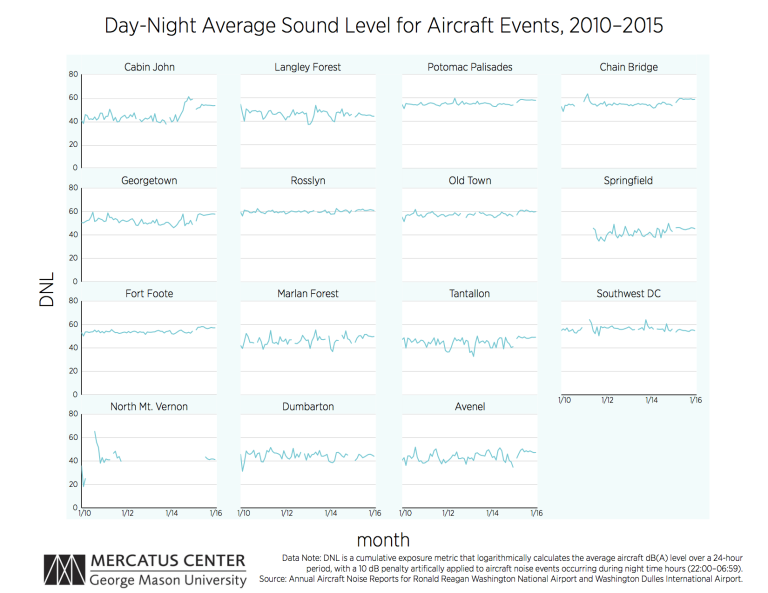- | Technology and Innovation Technology and Innovation
- | Data Visualizations Data Visualizations
- |
The Evolution and Distribution of Noise around Reagan National Airport
Some People Just Like to Complain
Airport noise is a part of living with the convenience of a nearby airport. While it is important that levels do not become intolerable, complaints alone are not a useful indicator of whether there is too much noise.

Airport noise is a contentious subject in Washington, DC, at least among a handful of vocal residents. The Mercatus Center recently published a policy brief that documents the concentrated distribution of noise complaints at airports across the country. For complaints lodged with Ronald Reagan Washington National Airport in 2015, 78 percent (6,852) were made by a single household in the Foxhall neighborhood in northwest Washington, DC. According to a report from The Outline that identifies the top complainer, the household is in Hillandale, an adjacent neighborhood, not Foxhall, as the Metropolitan Washington Airports Authority (MWAA) reports.

How bad is airport noise in Foxhall and Hillandale? Do the noise complainers there have a point? In order to answer these questions, we turned to noise monitor data collected by the MWAA between 2010 and 2015. As the chart shows, MWAA operates noise monitors at 15 locations surrounding Reagan National, selected in consultation with local governments. Neither Foxhall nor Hillandale is one of the 15 locations, but nearby Georgetown is, and the neighborhoods are located nearly directly on the line between the Georgetown monitoring station and the one in Potomac Palisades. By examining noise levels at these two monitoring stations, we can make some inferences about noise levels in the area in question.
The aviation industry uses a metric called the day-night average sound level (DNL) to aggregate the noise created by individual aircraft events. MWAA’s data show that measured aircraft noise levels in Georgetown have increased modestly in 2015 over previous years. In part, this increase is because in January 2015 MWAA upgraded its noise monitoring capabilities throughout the region to better distinguish between airplane noise and other noise generated from the ground. Some portion of the increase is also surely due to partial implementation of the FAA’s NextGen air traffic modernization plan. Potomac Palisades also experienced an increase in measured noise levels in 2015, though a smaller one than Georgetown did.
In both Georgetown and Potomac Palisades, however, noise levels remained as low as or lower than those experienced by Rosslyn and Old Town Alexandria throughout the entire 2010–2015 period. Old Town, like Georgetown and indeed Hillandale, is a wealthy neighborhood. One might expect that these neighborhoods would have similar levels of complaints given similar levels of noise. In fact, in the entire city of Alexandria (encompassing more than just Old Town), 39 individuals were responsible for 180 complaints, about 2 percent of the total volume of complaints. Nobody in Alexandria complained anywhere near as much as the single household in Hillandale, even though by objective measures, Alexandria residents experience as much or more noise.
Airport noise is a part of living with the convenience of a nearby airport. While it is important that levels do not become intolerable, complaints alone are not a useful indicator of whether there is too much noise. MWAA’s data show that noise complaints do not correlate with objective noise levels. Because noise levels in Foxhall and Hillandale do not exceed those in other parts of the city, the large volume of complaints originating from that neighborhood likely has some basis other than exposure to intolerable noise. Consequently, we infer that even vociferous noise complaints are not a reliable guide to sound policymaking. Statistically speaking, complaints are noise.